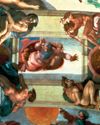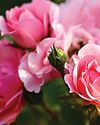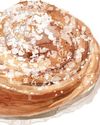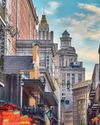
Grounded: A Journey into the Landscapes of our Ancestors James Canton (Canongate, £18.99)
THE author is a lecturer in 'wild writing', which suggests opium-fuelled poems by Thomas De Quincey or Woolfian stream-of-consciousness novellas scribbled in wind-blasted lighthouses. Rather, the discipline studies the links between literature, landscape and the environment. James Canton writes of what he teaches, Grounded being a personal exploration-both the literal act of journeying and mental voyage-around sacred spaces in Britain.
The obvious question is: what is 'sacred'? He generally means somewhere 'numinous', divine or spiritual. Churches are obvious cases, and he duly starts in musty, silent St James's, Lindsey, Suffolk, where he also gives us the direction of travel of his thesis: the need for a keen sense of calm', relief from the hurly-burly of modern life, connection with Nature, the wanting to be 'grounded'.
Dr Canton is not religious, but he is possessed by a sense of Other, and takes Buddhist meditation classes. More, he has a liking for deep history. Consequently, the 'spiritual essence' emanating from the sacred landscapes of our Palaeolithic ancestors is of particular focus, and so we visit the strange sarsen stones at Alphamstone, the haunting burial chambers at West Kennet, mysterious Blick Mead spring on Salisbury Plain. As he notes, the peoples of the past may be long gone, their monuments too, but 'the ground is slow to relinquish the signs of spaces that once held such importance'. Prehistoric barrows show up as contemporary crop circles, a link to the past that is at once ghostly, at once tangible.
Diese Geschichte stammt aus der February 08, 2023-Ausgabe von Country Life UK.
Starten Sie Ihre 7-tägige kostenlose Testversion von Magzter GOLD, um auf Tausende kuratierte Premium-Storys sowie über 8.000 Zeitschriften und Zeitungen zuzugreifen.
Bereits Abonnent ? Anmelden
Diese Geschichte stammt aus der February 08, 2023-Ausgabe von Country Life UK.
Starten Sie Ihre 7-tägige kostenlose Testversion von Magzter GOLD, um auf Tausende kuratierte Premium-Storys sowie über 8.000 Zeitschriften und Zeitungen zuzugreifen.
Bereits Abonnent? Anmelden

A trip down memory lane
IN contemplating the imminent approach of a rather large and unwanted birthday, I keep reminding myself of the time when birthdays were exciting: those landmark moments of becoming a teenager or an adult, of being allowed to drive, to vote or to buy a drink in a pub.

The lord of masterly rock
Charles Dance, fresh from donning Michelangelo’s smock for the BBC, discusses the role, the value of mentoring and why the Sistine chapel is like playing King Lear

The good, the bad and the ugly
With a passion for arguing and a sharp tongue to match his extraordinary genius, Michelangelo was both the enfant prodige and the enfant 'terribile’ of the Renaissance, as Michael Hall reveals

Ha-ha, tricked you!
Giving the impression of an endless vista, with 18th-century-style grandeur and the ability to keep pesky livestock off the roses, a ha-ha is a hugely desirable feature in any landscape. Just don't fall off

Seafood, spinach and asparagus puff-pastry cloud
Cut one sheet of pastry into a 25cm–30cm (10in–12in) circle. Place it on a parchment- lined baking tray and prick all over with a fork. Cut the remaining sheets of pastry to the same size, then cut inner circles so you are left with rings of about 5cm (2½in) width and three circles.

Small, but mighty
To avoid the mass-market cruise-ship circuit means downsizing and going remote—which is exactly what these new small ships and off-the-beaten track itineraries have in common.

Sharp practice
Pruning roses in winter has become the norm, but why do we do it–and should we? Charles Quest-Ritson explains the reasoning underpinning this horticultural habit

Flour power
LONDON LIFE contributors and friends of the magazine reveal where to find the capital's best baked goods

Still rollin' along
John Niven cruises in the wake of Mark Twain up the great Mississippi river of the American South

The legacy Charles Cruft and Crufts
ACKNOWLEDGED as the ‘prince of showmen’ by the late-19th-century world of dog fanciers and, later, as ‘the Napoleon of dog shows’, Charles Cruft (1852–1938) had a phenomenal capacity for hard graft and, importantly, a mind for marketing—he understood consumer behaviour and he knew how to weaponise ‘the hype’.